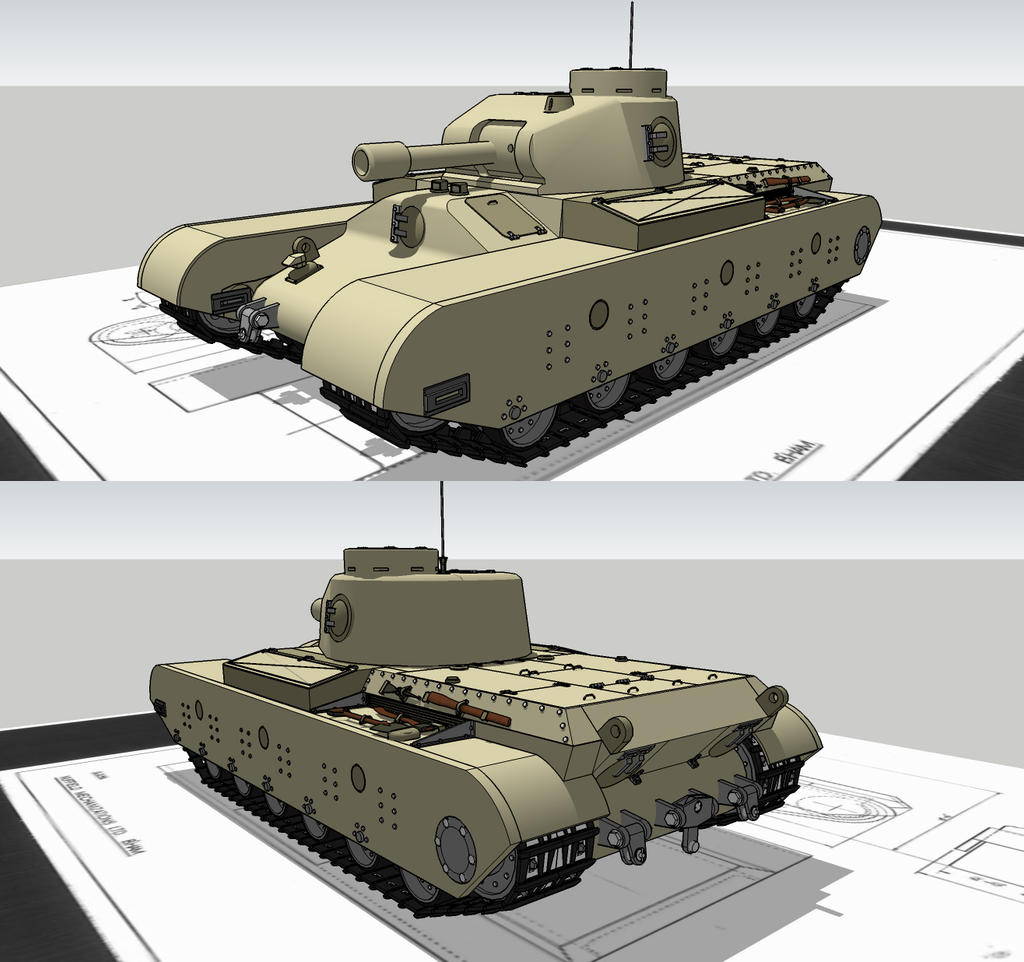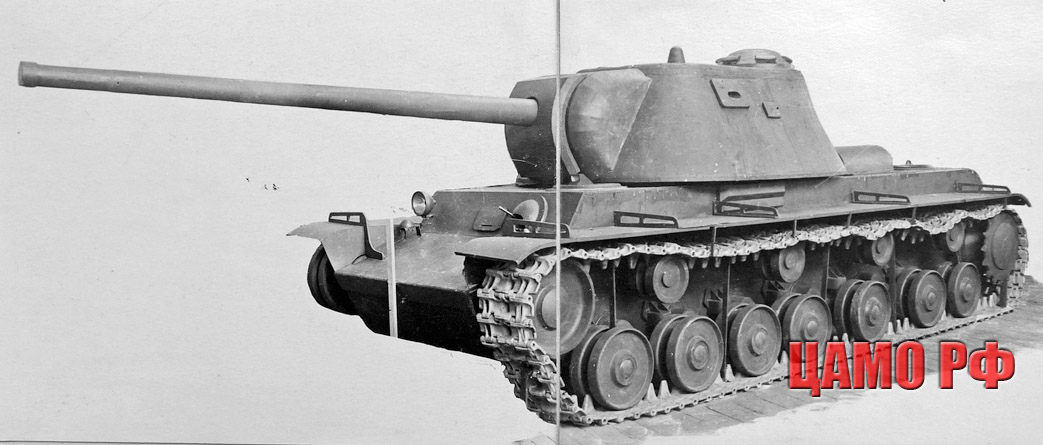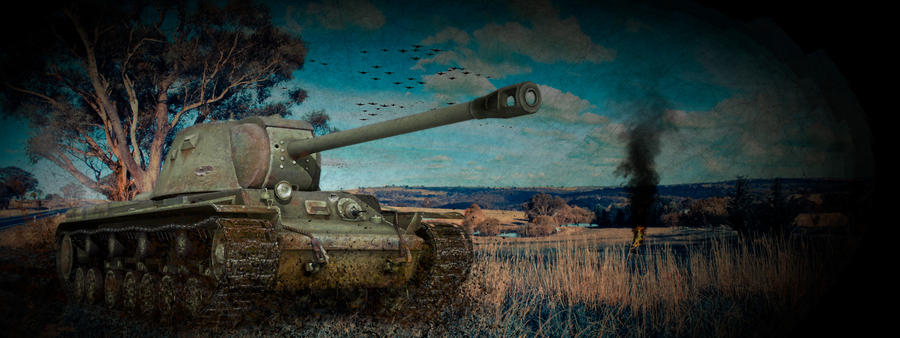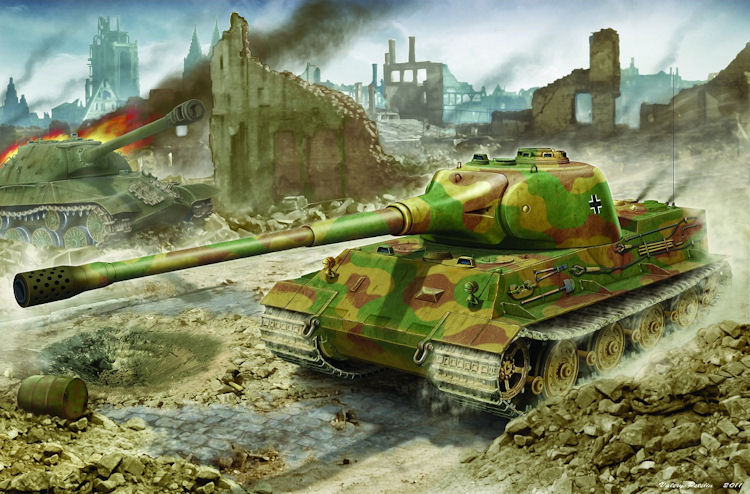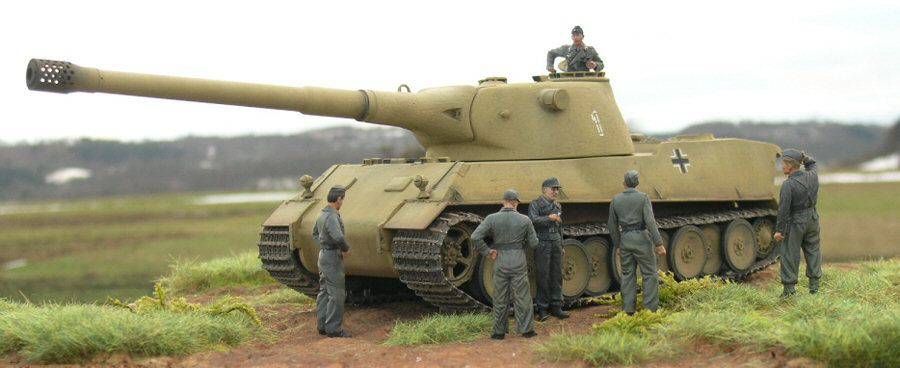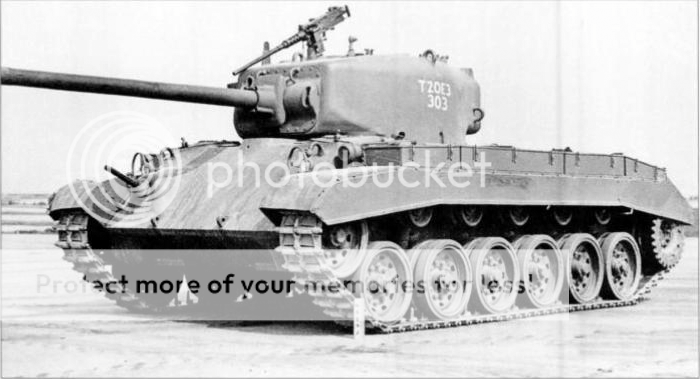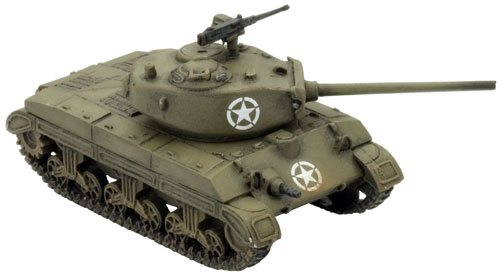In May 1940, after the experiences of the finnish war, and the peace treaty, the STAVKA deemed it necessary to produce a new heavy tank. Although the new KV-1 was starting to enter service, there were concerns that the heavier tank ‘only’ had the same calibre gun as the much smaller and older T-28, which had performed rather poorly in the war with Finland. The development team of the KV-1 was therefore called upon to begin studies on a new, more powerful machine. This lead to two diverging ideas initially labelled, for simple expediency, the KV-2 and KV-3.
The KV-2 would feature a 152mm short barrelled howitzer that could demolish concrete strongpoints or fortifications, like trenches in direct support of the Infantry. The KV-3 design was bolder, with the goal of creating a more capable all round machine. The KV-2 design was eventually deemed unsuitable in December 1940 when the first test vehicle-trials and it was found the tank was grossly unstable, thanks to the height and weight of its turret, and suffered from mechanical reliability issues due to the added strain placed upon its engine and drive train.
Needing something to be ready to display for their work, the design teams focused entirely on the KV-3 design. The hull of the new machine was to be based on the KV-1 but was longer, with extra road-wheels added, l and the body was made slightly wider, to accommodate a larger turret ring for the planned turret, as a bigger gun house would mean more room for the weapon itself.
The choice of armament caused more than a few disagreements and arguments, mainly because of the designers of the KV-2 pushing for a tank mounted version of the new M1938 122mm howitzer, but that weapons poor performance against armour ruled it out after tests. The weapon eventually chosen was the brand new M1940 107mm gun, a weapon that had formidable range and fearsome capabilities against armoured targets as proven during testing at Leningrad.
In terms of sheer size, the gun was bigger than any other equivalent in the world. The largest British, German, French or American tank guns were short 75 or 76mm howitzers, low velocity guns that lacked the raw punch of the much higher velocity 107mm gun. Collaborating with Alexander Morozov, who was working on his T-34 medium tank, helped speed the design of a turret capable of mounting the big 107mm gun.
The turret itself was quite revolutionary, thanks to Morozov’s influence and ideas, and the turret changed from the typical KV-1 boxy affair to a much more advanced design that featured a curved front and angled sides to increase the equivalent thickness of the armour without adding weight. This in turn cut down on the internal space in the turret but was countered by making the turret larger and slightly longer, capable of holding three of the KV-3’s five man crew. The Gunner, Loader and Commander would be housed in the turret whilst the Driver and Radio Operator in the forward part of the hull. Mirroring an idea from German machines, the KV-3’s Commander was given a raised cupola for improved vision without having to risk sticking his head out of the tank and all were to be fitted with radios as standard.
With the gun and turret designed, the already impressive armour of the base KV-1 hull was improved upon; the frontal hull was nearly doubled to a maximum of 120mm thickness whilst the flanks were 90mm thick. The turret itself was shielded by 120mm of armour frontally although thanks to the subtle curves and angling was considerably thicker. Yet this massive firepower and protection came at a cost, the KV-3 design grew rapidly in size with the tank ballooning to a massive 64 tonnes and it quickly became clear that the standard V-2 diesel engine simply was not adequate to push such a beast of a machine along at speed. Whilst the hull and turret were proceeding along nicely, the need for a new engine slowed development until a 750hp engine known as the V-2SN was developed, partially with the help of the navy as it was later to be used on Soviet river patrol boats. Extensive trials with the engine worked out most of its bugs and all were relieved when it was mated perfectly with the KV-3 hull.
The first KV-3 started trials in March 1941 and save for the prototype suffering a steering fault, resulting in it crashing into a copse of trees, there were no issues that could not be easily fixed. When demonstrated before members of the STAVKA including Stalin himself at the end of March, the new tank was immediately ordered into production at the Leningrad Kirov Plant, as well as Stalingrad alongside the smaller lighter and cheaper T-34.
By the end of May 1941, the planned 110 vehicles per month were being produced at Leningrad and when combined with the output from the Stalingrad factory there were 342 KV-3 tanks in service on the 22nd of June 1941 when the Axis forces began Operation Barbarossa. Because the KV-3 was brand new, none of them were near the border areas and suffered no losses during the initial German onslaught. Initially spread out amongst tank units to provide ‘backbone’ to the armoured divisions, this order was quickly rescinded and the KV-3’s started to be massed together in formations know as Heavy Tank Brigades along with their little ‘brothers’, the KV-1s.
Although lacking in tactical training, the crews knew their machines and the first Heavy Brigade went into action as part of the Yelnya Offensive.
Whilst the Germans had encountered KV-1 tanks in small numbers they had never seen the KV-3 before and the force of 36 KV-3’s supported by 48 KV-1’s caused mayhem. Horrified German Panzer crews watched their 50mm shells bounce off the Soviet tanks whilst their armour was not proof against the heavy 107mm shells of the KV-3’s. Even the 88mm Flak guns could not reliably defeat the armour of the Soviet machines at ranges long enough to be safe for the gun’s crew. Whilst the battle was a victory for the Soviet Union, the Germans were now deeply concerned. The KV-1 and T-34 had been unpleasant enough surprises as it was, the Soviet machines being far better protected and armed than an equivalent German machine but now they had a larger machine, bigger than any in the world that demanded a counter.
The initial reaction was to increase the production of the long KwK 40 L/43 gun on the Panzer IV but even this capable weapon was only effective at short ranges, when given a shot at the flank or rear of a KV-3 and was in no way proof against the 107mm gun. The major problems for the KV-3 was their limited tactical and strategic mobility, more KV-3s were lost due to them being bogged down or disabled through engine trouble than by German action and the big machines were a fine target for a competent Stuka pilot. Limited numbers also meant the tank could not be everywhere.
The German reply came in the form of the Panzerkampfwagen VI Tiger Ausf.E or as it was quickly shortened to the Tiger. A machine that, although lighter than the KV-3, was just as formidable. Its lethally accurate and high velocity 88mm gun could cut through the KV-3’s armour at a useful range and its thick armoured hide was proof against long range shots from the 107mm, meaning that both machines had to fight at roughly the same battle ranges against one another. Here the Tiger still had the advantage, its superior gunnery systems and optics as well as its better trained crews and the faster firing gun meant that it often got the first critical shot, before a KV-3 could. Yet chances for the two machines to meet remained few and far between: With Leningrad under siege the main production centre for the KV-3 was out of action and when Stalingrad was attacked the factory there was destroyed. Slowly but surely the KV-3 became a dying breed.
In early 1943 the Soviets began development of the successor to the KV-3 in the form of the IS-1, a smaller and lighter machine but one that was armed with an impressive 122mm gun. The smaller machine was more forgiving on the roads and bridges, whereas the KV-3 was limited in which bridges it could use due to its great weight. It was a joke in the tank arm of the Soviet army that the KV-3 was the world’s best destroyer of bridges; all you needed do was park it in the middle and wait.
The only time the Tiger and KV-3 truly clashed was on the battlefields of Kursk where the Heavy Brigades were deployed to try and counter the feared German Tiger and Panther tanks. When the Battle of Kursk, ended the honours between the KV-3 and Tiger were roughly even, it came down to who got their shot off first. The KV’s thicker armour protected it well against the superior German weapons, whilst the German could fight from longer ranges and always had the advantage of better trained crew.
With the end of the War the final active KV-3’s took part in parades in both Berlin and Moscow and were retired to depots or used as display pieces at monuments. A few found their way to the West, one is as the Aberdeen Proving Grounds whilst another in running condition sits opposite the Tiger tank at the Bovington Tank Museum. A few more, usually recovered from rivers or swamps in Eastern Europe are now in the hands of collectors.
